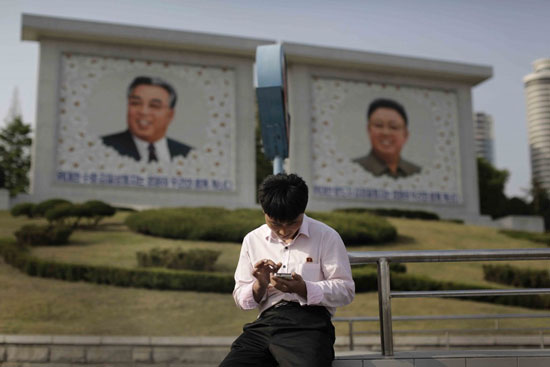- California Assembly OKs highest minimum wage in nation
- S. Korea unveils first graphic cigarette warnings
- US joins with South Korea, Japan in bid to deter North Korea
- LPGA golfer Chun In-gee finally back in action
- S. Korea won’t be top seed in final World Cup qualification round
- US men’s soccer misses 2nd straight Olympics
- US back on track in qualifying with 4-0 win over Guatemala
- High-intensity workout injuries spawn cottage industry
- CDC expands range of Zika mosquitoes into parts of Northeast
- Who knew? ‘The Walking Dead’ is helping families connect
Online shopping arrives in N. Korea, but many lack access

In this Tuesday, May 5, 2015, photo, a man sits in front of portraits of the late North Korean leaders Kim Il Sung, left, and Kim Jong Il, right, as he uses his smartphone in Pyongyang, North Korea. North Korean officials have unveiled a mobile-friendly online shopping site. (AP Photo/Wong Maye-E)
PYONGYANG, North Korea (AP) — Online shopping has arrived in North Korea, though it’s as isolated from the rest of the world as the country itself, and the vast majority of North Koreans lack the technology to use it.
The website Okryu, aimed primarily at smartphone users, offers products from North Korean companies including women’s clothing, bags, shoes, medicines, cosmetics, furniture and food. Payment, in local currency only, is taken from the main North Korean debit card system.
To keep it all hermetically sealed, the site works not on the World Wide Web but on North Korea’s own intranet, a self-contained version of the Internet set up and maintained strictly for domestic use. North Koreans call it the “domestic web” and it’s been around for years, but not used very much, largely because very few North Koreans have personal-use computers that can go online at all.
Smartphone use, however, is growing, and Okryu’s presence suggests that the government does not consider the technology to be a threat to the country’s rigid social order.
While cellphones are still largely absent from the countryside, it has become common to see people using them while walking down the streets of the capital. After years in which it limited mobile phones to elites or banned them entirely, North Korea began allowing their broad use in 2008. By 2013, the number of mobile and smartphones mushroomed to about 2 million, or nearly one for every 10 North Koreans.
Last year, North Korea’s mobile phone network, Koryolink, started allowing customers to use their phones to look at a very limited number of local websites — such as the ruling party newspaper, the state news agency, a TV show download site, a local university site and a science and technology site called “Hot Wind.”
Okryu (pronounced ong-yu) is managed by the General Bureau of Public Service, a government organization that oversees shops, restaurants and producers of consumer goods. Bureau official Jong Sol Hwa recently confirmed the online shopping site, announced with much pride by state media last month, is up and running.
It’s impossible to say how popular the new site is or if the average North Korean shopper is even aware of it. The site’s managers haven’t announced statistics about page views, unique users or sales volume.
During a demonstration for an AP Television News crew, a bureau official clicked on the site for the Kumsong Food Factory in Pyongyang and scrolled down to a pack of cream buns, which brought up a new page with that item and its price — 78 North Korean won (less than 1 U.S. dollar, depending on which exchange rate is applied), which is in line with prices at stores in Pyongyang.
The next step is to type in how many packs the user wants and tap the buy button. After hitting confirm, the purchase is finished.
How were the goods delivered? And when? Those questions weren’t answered in the demonstration, though they are critical to the website’s success. Foreigners — whether they are inside or outside North Korea — are barred from using the service.
North Korean shoppers may find it particularly useful that the site lists similar items together so they can compare prices. That is a luxury here because advertising is nearly non-existent and traveling to do bargain-hunting can be difficult. Evidently, the socialist country is content to inject some competition into its virtual world.















